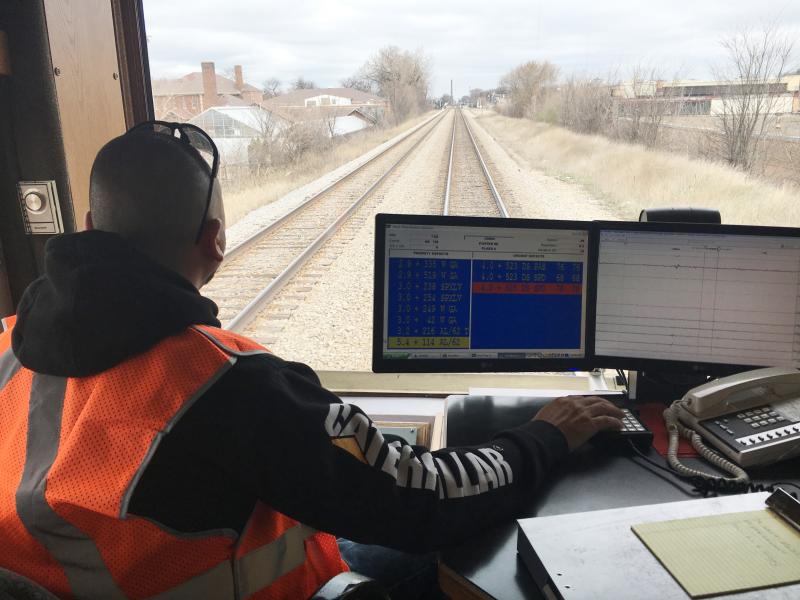Geometry car helps keep ride smooth and safe
Three men sit in the front of the rail car, back-lit silhouettes facing a large window, the rails spread before them like ribbons as the train rumbles forward. Computer screens display a continuous log of information as a calm automated male voice calls out each important detail of the track configuration. The words “switch,” “road crossing,” “bridge” and “milepost” are all recited in this automated monotone as the train heads out from Chicago Union Station west along Metra’s Milwaukee District lines.
But then the voice calls out the word: “Defect. Defect.”
As the details appear on the computer screen, Metra track inspector Manny Rangel uses a computer mouse to highlight the data while Project Roadmaster Jose Jauregui and Milwaukee District Roadmaster Arturo Lopez compare the data to the design profile for this section of track.
If the issue requires immediate repair, Lopez contacts the dispatchers along the route to initiate an order for trains to reduce speed over that section of track until the repairs can be made. He then dispatches the track employees to the site to make repairs. In most cases, repairs are made and track speed is restored within hours.

Metra Track Inspector Manny Rangel logs track conditions as he rides in the Canadian Pacific track geometry car along the Milwaukee North Line.
Depending upon the degree of variation from the track design and the type of defect, the track issues are classified “urgent” or “priority” defects. A priority defect means that the track isn’t meeting Metra’s own design standards but does not violate federal safety requirements. Priority defects do not require immediate repair but are put on a watch list that is used to inform planning for future track maintenance projects. A defect categorized as urgent, however, does require that a speed reduction be placed on that section of track until repairs can be made.
All of this is the routine of a trip on a track geometry car. Twice a year, Metra rents the Canadian Pacific geometry car to inspect every mile of Metra-owned tracks. Our partners in the Chicago region, BNSF Railway and Union Pacific, as well as the region’s freight railroads also use track geometry equipment to inspect track conditions several times a year.
Geometry cars use lasers and video to precisely measure the track alignment, cant or cross level (the difference in elevation between the two rails), curvature, rail gauge, warp and the rail profile. Some railroads also use trucks equipped with similar technology to ride the rails and provide measurements, but track geometry trains more accurately duplicate real-world conditions because the weight of the train itself subjects the track to the same lateral force the track is subjected to when a commuter or freight train passes over it.

The CP Geometry train sits next to Metra locomotive 426 as it waits to begin its trip south from Fox Lake.
In addition to geometry cars, Metra employs track inspectors who visually inspect every section of our railroads several times each week. Their familiarity with the segments of railroad under their watch makes them Metra’s first line of defense in identifying changing track conditions.
“Track inspectors are out there on a daily basis making sure that our railroad is in safe condition,” said Metra Chief Engineering Officer Bruce Marcheschi. “But the geometry car provides an extra level of information. It can identify immediate concerns but I would argue that its greatest value is the data it provides that helps us in our long-range planning. In fact, a rail replacement project currently underway on the Milwaukee North Line is a direct result of information gathered by the geometry train.”
Geometry cars are not the only specialized equipment that Metra uses to monitor track conditions. Another vehicle also travels the Metra system on a twice-yearly basis using ultrasonic equipment to detect defects within the rail itself. These defects cannot be seen by the naked eye and detecting them allows us to replace rail sections before breaks occur. Like other railroads, Metra will also contract the services of a rail grinding train to extend the useful life of the rail.
“Each of these specialized services help Metra safely maintain the track speed, smooth ride and levels of service to which our riders are accustomed,” Marcheschi said.